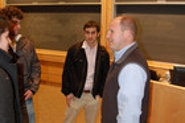
Dan Nye, a 1988 graduate of Hamilton College, spoke to a packed auditorium on Thursday, Feb. 7. Nye is the CEO of LinkedIn, the online professional networking site with more than 18 million members in 150 industries from around the world. His presentation, titled "Social Networking: The Next Generation" provided valuable information on the past, current and future state of social networking. The web, in existence for only 13 years, continues to expand in areas of content, audience, distribution and value.
Nye began the lecture with a question to the audience, "How many people are on Facebook or MySpace? Not surprisingly, the majority, if not all present, raised their hands. Having a hunch what the answer was, Nye continued, asking the students present to raise their hands if they were not on Facebook. With a quick look around the room, it was apparent no hand was raised. Point taken: social networking is a global phenomenon. And LinkedIn, a business-oriented networking site founded in December 2002 and launched in May 2003 is a competing global leader in professional networking. LinkedIn was founded by Reid Hoffman, former vice president of PayPal.
Humbly, Nye asked, "Why are people talking to me?" "What are they talking about? ... I didn't create it." But he has made a lot happen within the last year and has plans to "build the world's largest, most active and most valuable professional network." Nye says, "We're having an absolute blast seeing what we can do." He believes that what can happen on the Internet is "truly incredible."
Nye began the presentation with a timeline of where the World Wide Web has been and where it is going. It started with the PC era, when computers were connected by services like Prodigy, CompuServe, AOL and MSN. The Internet boom started when the Netscape browser was made available. A number of companies were created, focusing on publishing, search, online banking and e-commerce. The boom was followed by the dot-com bust, when many people were laid off and lessons were learned: business models matter and there was much more to learn about search and new approaches. Companies like Google, PayPal, Skype and Blogger joined in on the Web.
Today's Web 2.0 era refers to a perceived second generation of Web-based communities and hosted services, such as social-networking sites, blogs and wikis. This revolution in Web design and development promotes creativity, collaboration and sharing among users. Nye suggests that Web 2.0 has gained publicity because of a few factors: it attracts enormous audiences (shifting the Internet landscape); it facilitates high engagement levels; it has a social impact (people are posting regrettable, entertaining and interesting stories, social networks are disruptive and are changing society); the stakes are enormous (billions of dollars are in play) and finally, it's working!
Web 2.0 is working for a number of reasons. It has solved the distribution problem – distribution can now be made on a larger, extremely inexpensive scale. Web 2.0 is moving around the incumbents and is on a path of viral growth (what Nye calls the "viral engine"). The content on Web 2.0 is not only inexpensive but also unique because it is user-generated content (UGC). It is working because of its authenticity (users aren't hiding behind screen names – "people are who they are") and because the timing was right. LinkedIn and other networking sites such as YouTube, Facebook and hi5 are a part of Web 2.0.
LinkedIn enables professionals to create profiles, search for people, send messages, job recruit, obtain valuable news, make professional connections and search for positions, among other valuable applications
On LinkedIn, users may find alumni and employees from fellow NESCAC colleges (Hamilton, Middlebury and Amherst have the largest groups) as well as members from a wide range of industries, universities and business schools around the world and many major corporations. Approximately 6 million people use the site every month, and 1.2 million new members join at a rate of 300,000 a week or 30 per minute. Nye joked that if he can't sleep, he calculates the number of members who have joined since he has gone to bed.
To those thinking of entrepreneurship Dan Nye said, "think about the RUG (revenue, usage, growth) strategy." According to Nye, LinkedIn founder Reid Hoffman knew these were important when he began. First an entrepreneur must fund the business as long as possible before asking for venture capitalists support. Then an entrepreneur must ask, "What do we need to do to get venture capitalists to fund more?" On the Internet an entrepreneur must start with growth, spend money to build a product that works, find people to use it, to tell friends, who will then tell more friends and then consider expanding available capital. Nye stressed the importance of building a strong business model. LinkedIn stuck to its game plan and it paid off. Dan Nye is now in the driver's seat, keeping the business strategies of his predecessor in mind and moving in a direction that looks promising.
Dan Nye ended with advice he says is sound and was taught to him by his mentor. He says he may live in an area (Silicon Valley, Calif.) where 22-year-olds build billion dollar companies, but that is the exception not the rule. The real strategy to being successful is to "focus on skill development...it's not about the money. You have to enjoy what you're doing and you have to surround yourself with great people who will make you better at what you do. Without the confidence and skill you won't make it," he said.
-- by Kateri Whitebean '08
Posted February 8, 2008
